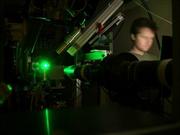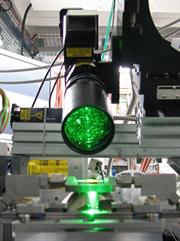Renishaw adds Raman capabilities to synchrotron research
 Over the last few months, Renishaw engineers and beamline scientists from the Swiss Norwegian beamlines (SNBL) have developed novel Raman probes to advance cutting-edge Synchrotron research. Wouter van Beek and a team of scientists working at SNBL, use simultaneous X-ray diffraction (XRD), extended X-ray absorption fine structure (EXAFS), Raman, and mass spectroscopies (MS), to monitor the kinetics of catalytic reactions insitu.
Over the last few months, Renishaw engineers and beamline scientists from the Swiss Norwegian beamlines (SNBL) have developed novel Raman probes to advance cutting-edge Synchrotron research. Wouter van Beek and a team of scientists working at SNBL, use simultaneous X-ray diffraction (XRD), extended X-ray absorption fine structure (EXAFS), Raman, and mass spectroscopies (MS), to monitor the kinetics of catalytic reactions insitu.
New research avenues
Renishaw scientists and engineers have worked with the team, based at the European Synchrotron Radiation Facility (ESRF) in France.
Developing new probes that enable the scientists to perform their experiments more rapidly and efficiently. The integrated set-up is now fully operational and it will open up new avenues of research and offer vital new detail for studies in solid state chemistry including nano-materials, catalysis, biology (protein crystallography), and environmental science.
Unique, customised hardware
 The new SNBL hardware augments their current Renishaw equipment.
The new SNBL hardware augments their current Renishaw equipment.
This comprises six different fibre optic Raman probes, and three online video systems with relay lenses to provide high numerical aperture at long working distances, all connected to a Renishaw inVia spectrometer. The probes enable in situ operation at two remote synchrotron stations, and ex situ use attached to a macro chamber on the inVia. This ex situ / in situ use with the same experimental setup is crucial; the ex situ work enables analytical conditions to be optimised prior to costly on-line experiments (where materials are monitored as they change under external stimuli such as pressure, temperature, or corrosive gas).
Wouter van Beek explains
“I decided to work with Renishaw, first because their engineers immediately understood my complex specifications with respect to applications and implementation, and second because they were able to build upon our ideas, suggest novel solutions to implement them, and even surpass our requests.”
Contact us with your beamline requirements
This project capitalises on Renishaw’s extensive experience in developing customised beamline systems; these are installed at ESRF (three systems), the Daresbury Synchrotron Radiation Source, Rutherford Appleton Laboratory ISIS neutron/muon source, and the new Diamond Synchrotron source in Oxfordshire. Contact us so we can discuss your beamline system requirements.
Full Article
-
 Renishaw Raman Press Release Synchrotron
Renishaw Raman Press Release Synchrotron
Press Release describing the use of custom Renishaw Raman tools at the SNBL Beamline facility in Grenoble, France.
[726kB]
Editor download
-
News release: Renishaw Raman Synchrotron
Press Release describing the use of custom Renishaw Raman tools at the SNBL Beamline facility in Grenoble, France.
[1.0MB]
Images
All documents and images copyright Renishaw plc

